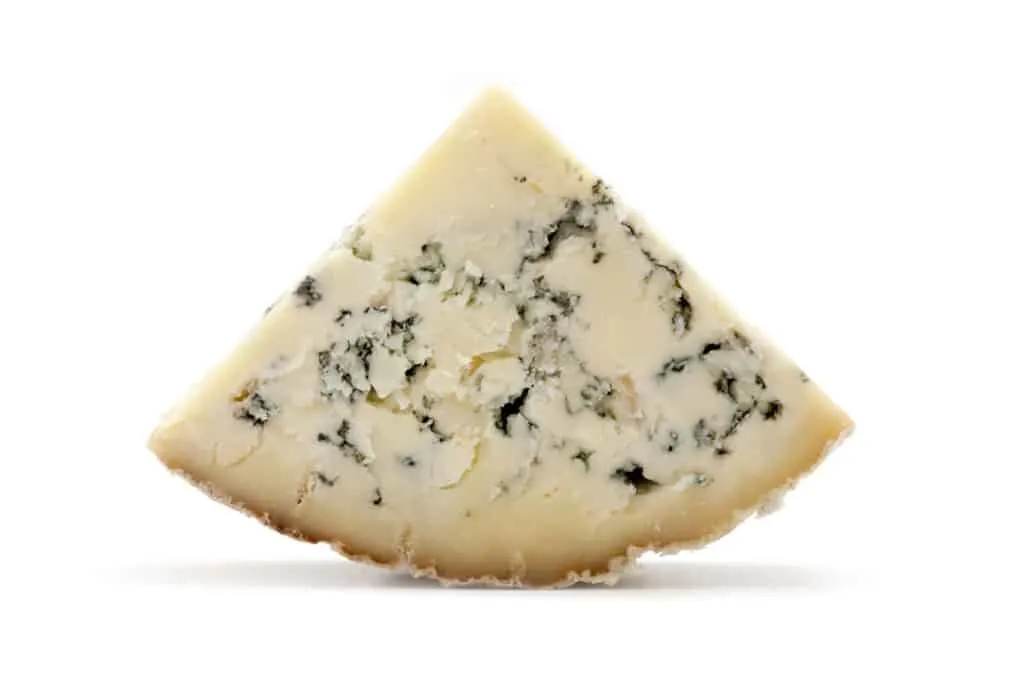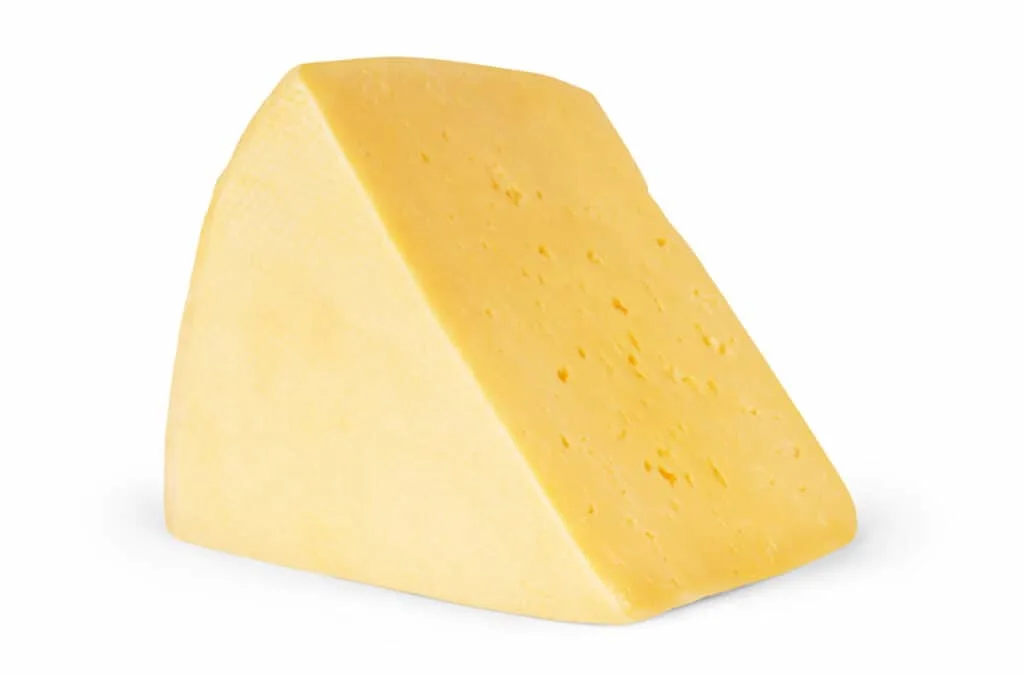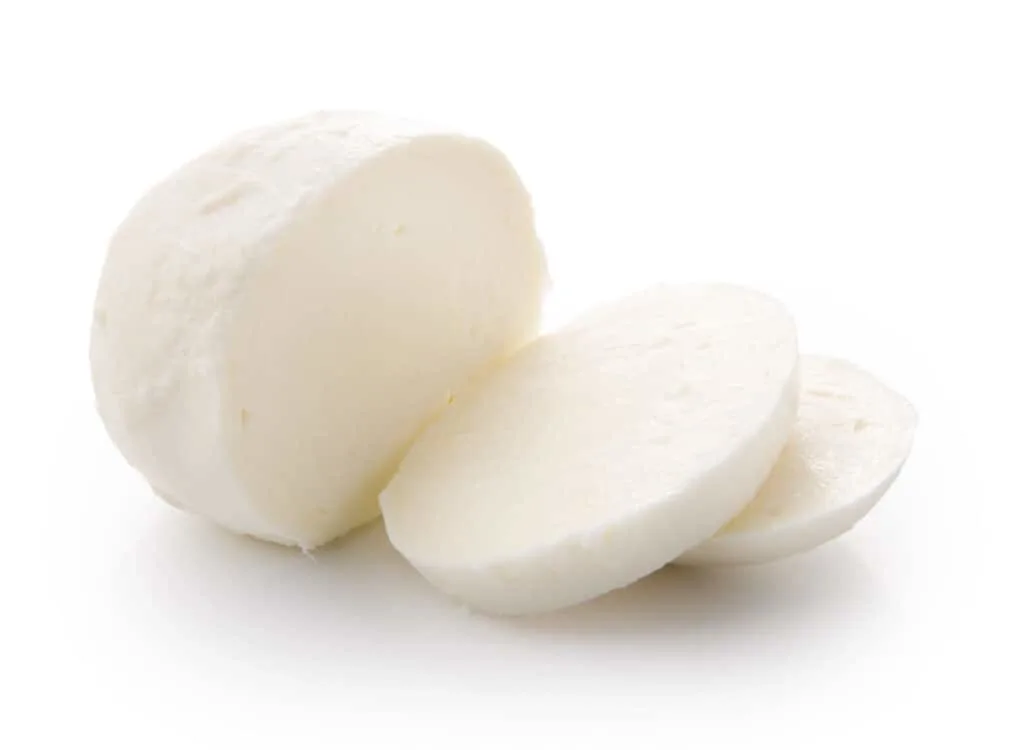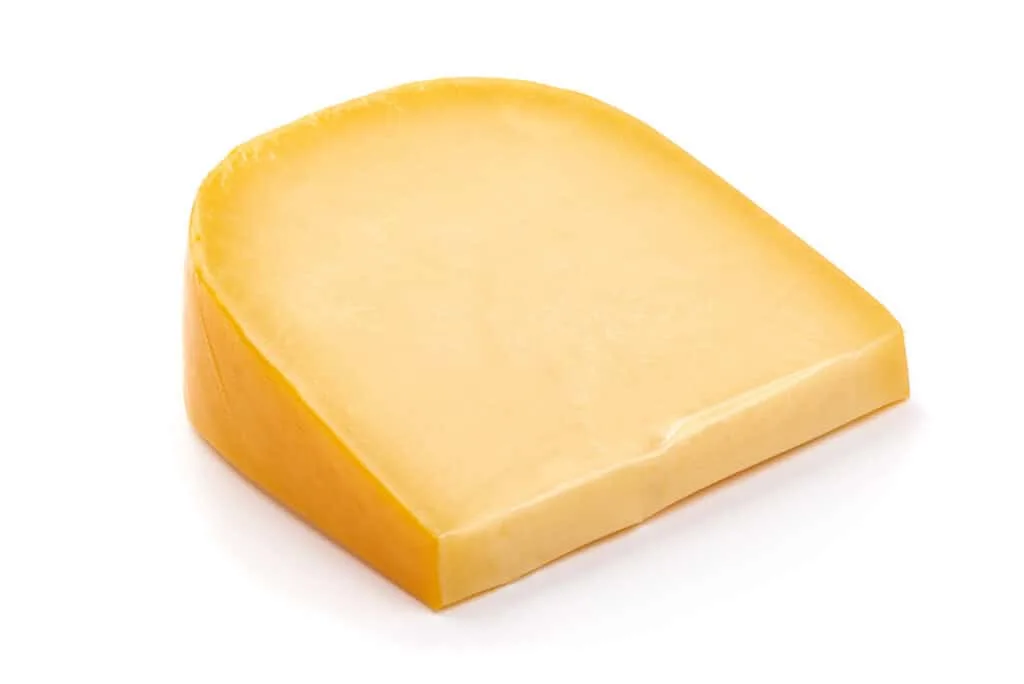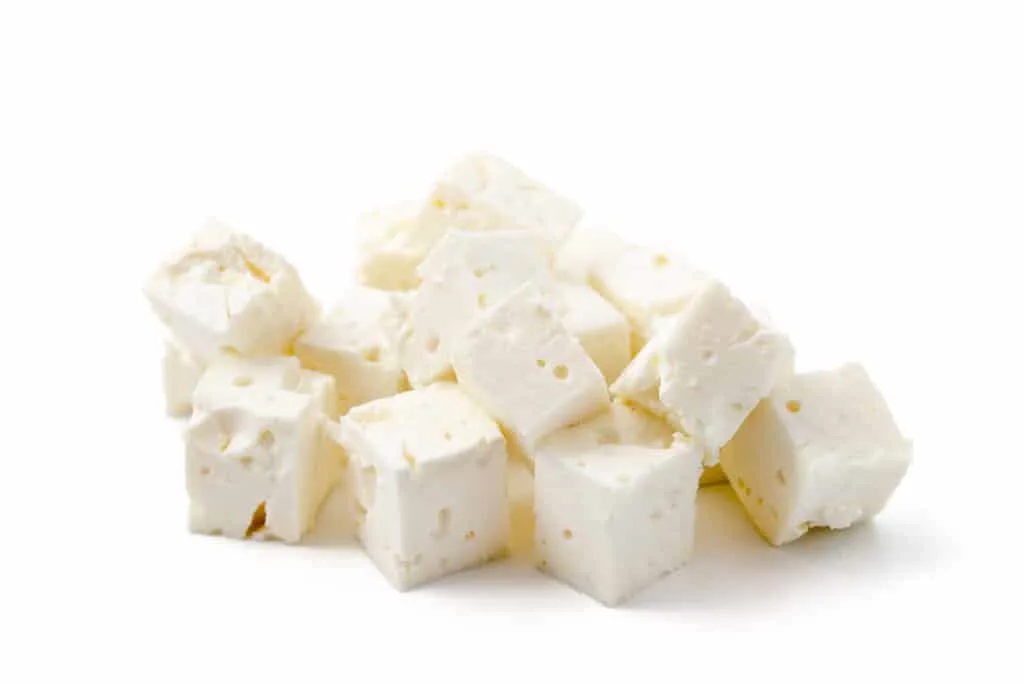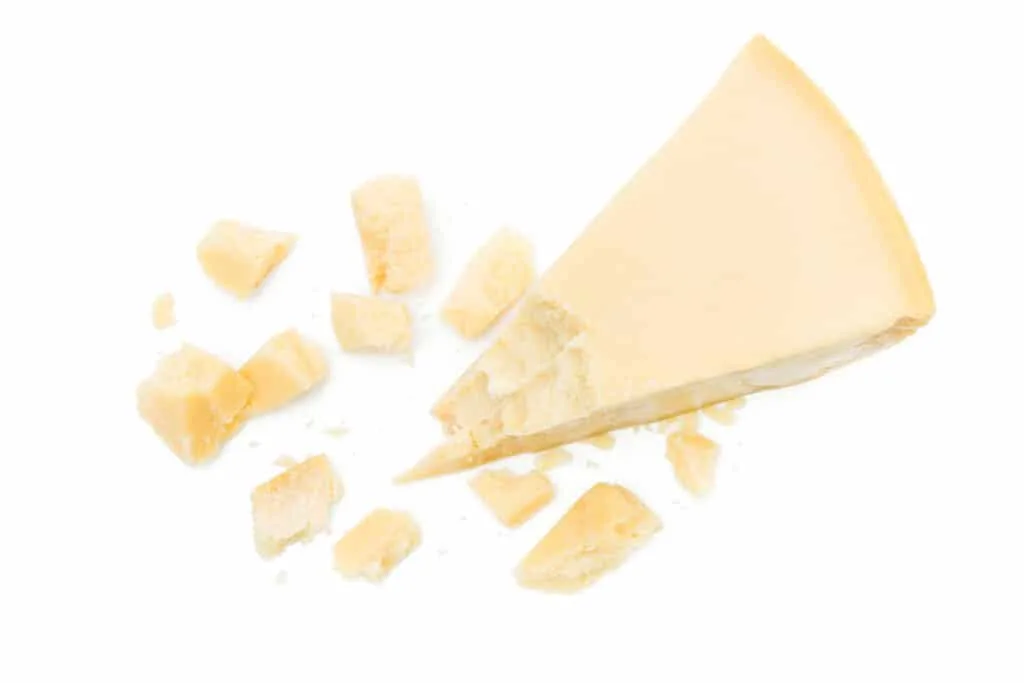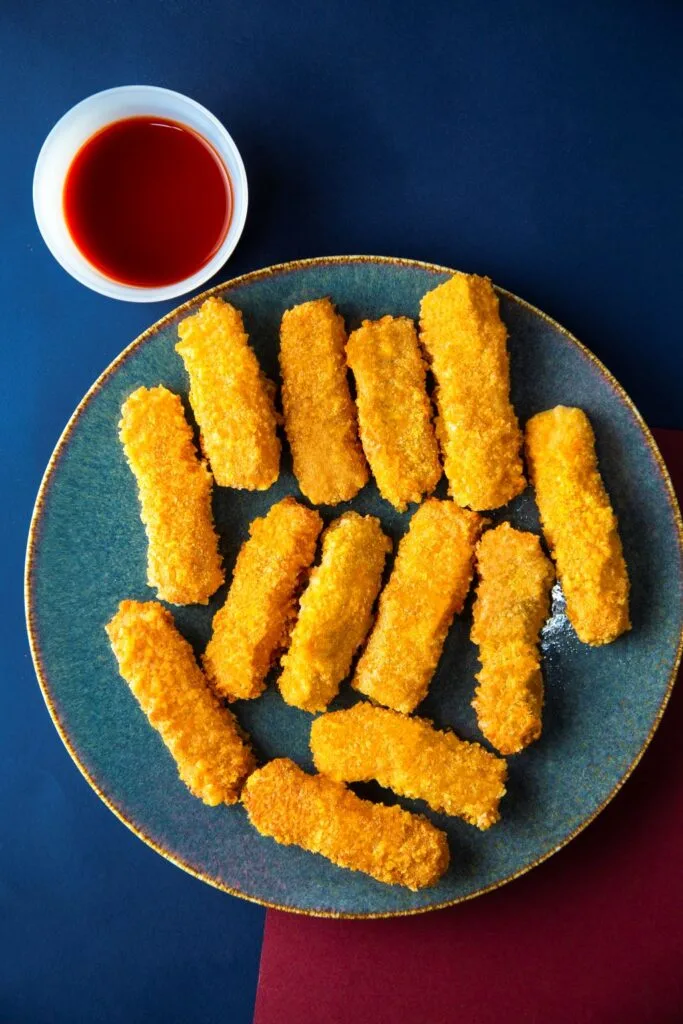Did you know there are over 1,000 types of cheese to choose from?
They vary from hard cheeses, soft cheeses, blue cheeses, cheese that is perfect for melting and strongly flavoured cheeses perfect for grating over your meal.
Each one has its own distinct flavour and texture.
Don’t worry, I’m not going to talk about every type of cheese there is – but let’s get started with 16 of the best types of cheeses to buy.
Stilton
Stilton is one of the most distinctive blue cheeses. Its creamy white texture and marbled blue veins streaking throughout is iconic. This is a cheese that will split a crowd down the middle – half of them loving it and half of them hating it. This is due to its strong, distinctive flavour and soft texture.
Stilton originates in England and is still made only in a few parts of the heart of England today. This is a cheese that is perfectly made for spreading on crackers but it also makes a great base for a strong blue cheese sauce. You can also crumble it over salads and it is surprisingly lovely paired with apples, walnuts and honey. Stilton also tastes delicious when added to a hot soup, especially broccoli and stilton soup.
Cheddar
Cheddar is another iconic British cheese. This one originates in a small village in Somerset, England and is named after the village too. You can still visit the original cheddar cheese factory and take a tour showing you how this cheese was made. Nowadays, this cheese is made everywhere and is the most popular cheese in the UK and the second most popular in the US.
Traditionally a pale and creamy yellow in colour, cheddar is a relatively hard cheese although you can also get an orange variety. Cheddar is the most popular cheese simply because it is so versatile. You can choose the strength of flavour you prefer, and it is perfect for sandwiches, in sauces, grated over meals or as an addition to any recipe that requires a cheese base.
Related:
Toasted Cheese and Ham Sandwich
Mozzarella
Moving away from England we come to mozzarella, a soft Italian cheese that is traditionally made from buffalo milk. If you buy traditional mozzarella it is usually served very fresh, within a day of it being made. This is because it has a very high water content and it makes it a very delicate cheese.
Mozzarella is available to buy in rolled balls, fresh or kept in brine. There are even some low moisture content varieties made that can be shredded so they keep a little longer and are easier to work with. Mozzarella is a very soft and pliable cheese, usually pale white in colour. It has a mild taste that isn’t overpowering. It is its delicate, stretchy and mild nature that makes it perfect for its widest use in meals – it’s regularly voted the best cheese to use on pizza!
Related: Hunter’s Chicken – Cheese and Bacon Pasta Bake
Gouda
Gouda is a buttery type of cheese, wonderfully creamy in texture with a distinctive nutty taste. It is classed as a semi-hard cheese, although different varieties do offer slight differences in texture. Older Gouda cheeses will be harder and will also have a more pungent taste. This cheese originated in The Netherlands but has since become a firm favourite the world over.
Gouda is a cheese that melts well making it perfect for toasted sandwiches or even to add an extra depth of flavour to the pizza. Its smooth flavour also makes it the ideal option for a cheeseboard or in sandwiches.
Related: Ham and Cheese Toastie
Emmental
The Swiss are known for their cheeses and Emmental is a type of cheese that has become iconic the world over. Mild in both colour and flavour the most distinctive aspect of this cheese is the holes that form during the production of the cheese.
Made from cow’s milk, the name comes from the region it originates from, the river Emme in Bern. This is a cheese that can differ in flavour depending on how it is made but it generally smooth in texture and mild in taste with a buttery and nutty flavour. This is another cheese that melts really well, so any recipe that requires melted cheese is perfect, although it is also lovely cold and in sandwiches!
Feta
When it comes to salads and starters, you can’t beat a good feta cheese. This is a soft cheese made from sheep’s milk and its name literally means ‘slice’, probably because of how it is sliced into blocks and then sold in small slices. Originally made in Greece, this is a cheese made from brined curds, and it forms a distinctive crumbly texture.
Feta forms the basis of many Greek salads and dishes, often cut into cubes or crumbled over salads and dishes to add flavour. It is also the perfect cheese to add to omelettes. You can even melt it into a sauce for a full-bodied sauce to add to any dish.
Brie
Brie is a soft, pale cheese that originates from the Brie region of France. Made from cow’s milk the cheese is a pale yellow with a rind that forms around it. You can eat both the cheese and the rind – the rind is actually considered a delicacy so next time you eat Brie don’t cut off this delicious part of the cheese.
The soft, creamy texture of Brie makes it a firm favourite among cheese connoisseurs everywhere. The buttery flavour is both mild and distinctive at the same time! Brie is best served at room temperature as part of a cheese board, and it works well spread on crackers or bread. You can also bake Brie for a delectable starter or side dish.
Parmesan
Parmesan is a staple in Italian restaurants and is a very hard cheese that is dry in texture. Parmesan cheese originates in Italy and is made from cow’s milk. Generally, this is a cheese that is aged for at least two years. This is what gives it its very hard texture with a dark rind, and it is traditionally used as a grated cheese to add a salty flavour to a meal.
Parmesan can differ in both flavour and texture depending on how it was made but is generally very dry and grainy with a strong nutty flavour and a strong aroma. It is mostly used to grate over pasta dishes but you can also use it in risottos or melt it into soup.
As a bonus, parmesan rinds pack in bundles of flavour so don’t throw them away. Instead, toss a parmesan rind into your next soup, and you’ll take it up to a whole new level of flavour.
Recipes Using Parmesan:
Spaghetti Carbonara
Slow Cooker Spaghetti Bolognese
Puff Pastry Cheese Straws
Mascarpone
Another iconic Italian cheese is Mascarpone. This is an old cheese that dates back as far as the 16th century! Mascarpone is made from cream instead of milk and is produced by using a citric acid such as lemon juice to solidify the cream into a cheese.
Mascarpone can be a little confusing as its texture and substance is more similar to cream than cheese but the soft, creamy and silky texture of the cheese is what makes it so wonderful. It spreads easily and its sweet flavour makes it perfect for spreading on desserts and cake. It is also a key ingredient in tiramisu.
Related: No Bake Lemon Cheesecake
Gruyere
One of the best cheeses to come out of Switzerland is Gruyere. This is a cheese that is easily equal to, if not better than the iconic Emmental cheese. Gruyere is a semi-hard cheese, similar to cheddar in texture and has a similar pale yellow colour too. Where Gruyere is different is its flavour. It has a nutty taste that is creamy and mild whilst still being distinctive.
Gruyere is considered to be a table cheese which means it is perfect served cold on a platter, cheese board or in a sandwich. Another great thing about this cheese is how wonderfully melty it is. This cheese melts beautifully so add it to a sauce or any recipe that requires melted cheese.
Halloumi
A white cheese made from two types of milk, usually goats and sheep’s milk, although it is occasionally made from cow’s milk too. Halloumi originates from Cyprus and its distinctive property is how well it holds its shape without melting.
Halloumi has a distinctive texture and taste that can take some getting used to. Salty in flavour and rubbery in texture this cheese is best served cooked and it can be easily grilled, fried or baked for a delicious snack such as halloumi fries. The easiest way to cook it is to pan-fry thin slices and then add these slices to a sandwich or bap to make a delicious halloumi burger, or cut into chip shapes and use them as a side dish with sweet chilli sauce. It also adds a tasty twist when fried or baked halloumi is added to a salad.
Related – How To Cook Halloumi
Paneer
Paneer originates in India and is made by curdling buffalo milk until it forms a soft cheese. Paneer is made freshly and unaged. You use it almost as soon as it’s been produced!
Paneer can be eaten fresh but it is best cooked and served as part of a meal. Traditionally it is used cut into cubes and cooked into curries but you can add it to most meals – don’t try and use it melted. This is a cheese designed to retain its shape and texture even when it is being heated.
Camembert
If you are looking for a traditional French cheese, then Camembert is the most iconic. Originating in Normandy this cheese is made from cow’s milk and can be either raw or pasteurised. Camembert is a soft cheese with a super silky texture and is noted for its pale soft texture and bloomy white rind.
Camembert can be eaten raw or cooked. As part of a cheese board it is best served at room temperature so the soft, gooey centre has a chance to start to soften. This is a versatile cheese that can be enjoyed on its own with crackers or as a delectable starter or side dish. Baked, fried or raw this is a cheese that doesn’t disappoint.
Ricotta
Most cheese is made from curds of milk but ricotta is different. Ricotta means recooked in Italian which is where this cheese originates. It is made from the whey rather than the curds made during the cheesemaking process and this ends up with a light, fluffy cheese that is best eaten fresh.
Ricotta has a slightly sweet taste with a light fluffy texture that makes it perfect for using as a stuffing for pasta or vegetables. It makes a lovely addition to a traditional lasagna and can be used in sauces to add flavour and to thicken them.
Related: Slow Cooker Lasagne
Cottage Cheese
Cottage cheese is one of the oldest types of cheese in this list. It is thought to originate in the middle east as far back as 5000 BC! Cottage cheese is a fresh cheese that means it isn’t aged. It is made from cheese curds that are drained instead of pressed which gives it that lumpy texture that it is known for.
Cottage cheese is a versatile cheese that has a mild and creamy flavour that can be added to and paired with both sweet and savoury foods to add some extra interest. It makes a great addition to salads and is lovely on jacket potatoes and in sandwiches.
Cream Cheese
Cream cheese is another English originating cheese but it is popular the world over making the basis for many recipes, meals and snacks. It is a fresh cheese that isn’t aged and it has a soft, creamy texture although the texture can be dependent on the recipe used.
The taste of cream cheese is fairly mild which is why it makes a great base for snacks, on sandwiches and added to jacket potatoes. You can even turn it into a sweet topping for cakes!
Each cheese has its own recipe, requirements and even animal type. The diet that the animal ate also has an effect on the kind of cheese produced and adds to its unique flavour. This is before you even get to the ingredients and process to make each cheese. It is this wide variety of techniques and ingredients that means we have over a thousand types of cheese to choose from!
Cheese is one of life’s little pleasures.
It is the perfect addition to all sorts of recipes, and it makes the basis for so many meals, sauces, sides and accompaniments. Most of our favourite meals contain cheese! Cheese even sits pride of place when you are entertaining or having an evening out.
What’s your favourite cheese? Let me know in the comments!

